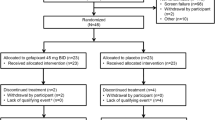Abstract
The prophylactic intranasal medication with a new antiviral compound, 1-phenyl-3-(-4 phenyl-2-thiazolyl) guanidine (CL 88, 277) was evaluated in humans against rhinovirus 44 challenge. One ml containing 250 mg of CL 88,277 was administered to 10 seronegative volunteers three times a day plus one dose prior to the rhinovirus challenge (32 TCID50) and for six consecutive post-challenge days. Ten other subjects received 56% polyethylene glycol (PEG-400), the solvent of CL 88,277, at the same time. Five subjects in each of the CL 88,277-treated and placebo-treated groups developed illness. There were no differences between the two groups in the occurrence of the severe illness and of the moderate and severe illnesses. Each sign and symptom occurred almost equally in the two groups and there was no difference in their scores between the two groups. The challenge virus was isolated from both groups but the total number of the virus isolates was less and the time span of virus excretion was shorter for the drug-treated group. The post-challenge serum antibody titers were markedly lower in the drug-treated group.
Prophylactic intranasal CL 88,277 medication did not affect the course of illness induced by rhinovirus 44 challenge. It appears, however, that the virus replication in the nose was reduced and as a result the serum antibody response was diminished. PEG-400 caused a transient irritation of the nasal mucosa in all recipients.
Similar content being viewed by others
References
Preclinical trial brochure, CL 88,277, antirhinoviral compound. Lederle Laboratories, A Division of American Cyanamid Company, Pearl River, New York, March 1975
Clinical report: Multiple dose tolerance study of CL 88,277, an antirhinoviral agent administered intranasally to human volunteers (Phase 1 study). Lederle Laboratories, A Division of American Cyanamid Company, Pearl River, New York, December 1975
Togo, Y., Schwartz, A.R., Hornick, R.B.: Failure of a 3-substituted triazinoindole in the prevention of experimental human rhinovirus infection. Chemotherapy18, 12–26 (1973)
Schwartz, A.R., Togo, Y., Hornick, R.B., Tominaga, S., Gleckman, R.A: Evaluation of the efficacy of ascorbic acid in prophylaxis of induced rhinovirus 44 infection in man. J. infect Dis.128, 500–505 (1973)
Pachuta, D.M., Togo, Y., Hornick, R.B., Schwartz, A.R., Tominaga, S.: Evalution of isoprinosine in experimental human rhinovirus infection. Antimicrob. Ag. Chemother.5, 403–408 (1974)
Author information
Authors and Affiliations
Additional information
This study was supported by a grant from Lederle Laboratories, Pearl River, New York
Rights and permissions
About this article
Cite this article
Togo, Y., Durr, F.E. & Laurenzana, D.A. Clinical evaluation of prophylactic intranasal 1-phenyl-3-(4-phenyl-2-thiazolyl) guanidine (CL 88,277) medication against rhinovirus 44 challenge. Med Microbiol Immunol 163, 37–44 (1977). https://doi.org/10.1007/BF02126707
Received:
Issue Date:
DOI: https://doi.org/10.1007/BF02126707




